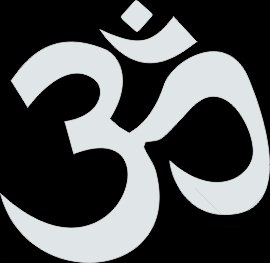Om, Aum, Ohm, Hum, Hmm…
Om is an ancient mantra, word, or syllable, that throughout the ages has been considered significant or auspicious*. Different traditions may have slight variances in pronunciation, but all have harmony in their various interpretations of the aspects of Om.
*Auspicious means ‘overflowing with promise of future success’.

The sounding of Om creates vibrations within our bodies that activate the parasympathetic response (rest and digest), and help us be clearer in our thoughts and focus. It is often used at the start of yoga classes to bring the participants into alignment with the teacher and each other, and prepare for clarity and focus on the practice at hand. It is also used at the close of yoga practice to celebrate the journey together and promote unity among the practitioners. It is also a celebration of our connection to our Divine Source. Our entire material world and existence is dependent on vibrations and cycles, from the spinning of the electrons in the atoms of our cells to the orbits of the earth, stars, and galaxies. All of these aspects are contained within Om.
Making the Sound of Om (Aum)
In the ancient root language of Sanskrit, the pronunciation has three sounded parts. ‘Ahh’, ‘Oooh’, and ‘Mmm’, followed by a brief moment of silence. Some traditions may simply pronounce ‘Om’ without the traveling vowel movement of a diphthong.
Begin with the mouth open, sounding ‘AH’ that vibrates from the center of the being, then the lips shift as the sound moves upward and forward and morphs into ‘Oooo’ sounding from the upper throat and mouth, then continues, ending with the lips together on ‘Mmmmm’. The sounded section is followed by a brief pause of the breath before the next inhalation.
What Does It Do?
First, it’s relaxing. The repeated sounding of Om helps calm the fight or flight response and help establish calm in the body and mind. The continuing vibrations from the sustained sounds stimulate the organs in the thoracic cavity (chest) and the glands in the neck and head. The Thyroid is stimulated, as is the thymus, pituitary, and pineal glands in the head. Circulation is enhanced and muscular tension is reduced.
When we focus on the meaning of Om, on the reminder of our legitimate and valid part in all things, and on our connection with each other and our Divine Source, this can help us with anxiety and issues of fitting in. The aspects of connecting with Divine Source can also encourage greater spiritual awareness and well-being.
And it feels good.
What Does Om Mean?
Both the sounding and the symbol have many interpretations. The three sounded parts correspond with the ‘3’ with the squiggle. The crescent and dot correspond with the silence after the sounded parts.
The ‘three’ on the symbol and the three sounded parts represent aspects of the human experience. Here are a few of the interpretations:
- Childbirth and Infancy, Adulthood, Sunset Years, and Death
- Past, Present, Future
- Mind, Body, Spirit
- Ourselves, Our Family, Friends and Associates, The World
- Conscious State, Dream State, Subconscious State

The crescent and dot (Bindu), and the silence following the sounding of Om represent that which encompasses the world and our human state, and all of that which is beyond. The Dot represents Eternal Divine Consciousness, or in the philosophical sense, our highest self. The crescent can represent either that which restricts our understanding and perception of this, or that which connects us to the same. The silence can also represent our departure from this state of illusion, and our transition into the next state of being, awareness, or experience.
Some believe that Divine Source contains everything and IS everything.
Om represents all that is created, all that is spiritual, and the infinite beyond, so Om is considered by some to be one of the names of God.
Next: Why THREE Times?

